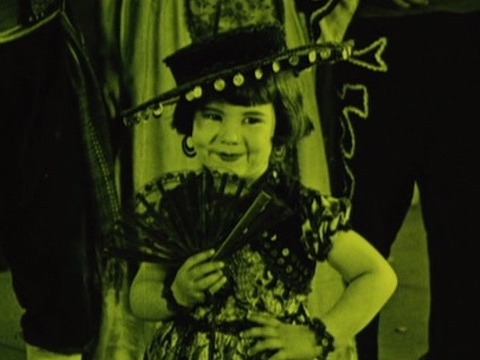CARMEN, JR.
Alf Goulding (US 1923)
Carmen, Jr. stars Baby Peggy (Diana Serra Carey) in bullfighting mode. The child prodigy of the silent screen plays a hilarious version of Carmen, dancing the tango and dreaming of being a matador. The film is set in Spain, with its sun-drenched landscapes, traditions, and stereotypical features.
The musical accompaniment, performed by the orchestra of the P. P. Pasolini secondary school rehearsed by their teacher Laura Martin, picks up the Toreador’s motif from Bizet’s Carmen, offering dreamlike, Spanish-style tunes that follow the rhythms of the scenes. These melodies are composed by Patrizia Avon, together with popular themes reworked for an instrumental group (flutes, cello, percussion, and castanets) and piano accompaniment.
Patrizia Avon
Carmen, Jr. finds Baby Peggy in old Spain, where she makes fun of various Carmen pictures and does a double-dipping spoof of Fred Niblo’s 1922 Blood and Sand. The first reel finds Peggy roasting Nita Naldi’s femme fatale wiles, while in Reel 2 she ends up throwing the bull à la Rudolph Valentino. Rudy’s famous tango from The Four Horsemen of the Apocalypse (1921) is also fair game for the diminutive comedienne.
Century Comedies was formed in 1917 by Abe and Julius Stern to exploit the talents of Alice Howell; however, by the time the 1920s rolled around their main headliners were lions and dogs. Peggy started out as an unbilled sidekick to Brownie the Wonder Dog, but soon became the company’s breakout star. As such they put her in the hands of talented comedy creators like Fred Hibbard (aka Fred Fishback), Arvid E. Gillstrom, and Alf Goulding.
Having the opportunity to chat with the adult Diana Serra Carey a few years ago, she told me that her favorite director had been Goulding. In addition to treating her warmly, she felt that because he had started his career as a child with the theatrical troupe Pollard’s Lilliputians he was more patient and understood how best to work with her. After touring the world with the Lilliputians Goulding had settled in California. Another former Lilliputian, Snub Pollard, recommended him to Hal Roach, and Goulding began directing Harold Lloyd in 1917. Lloyd later noted in his autobiography: “Goulding proved to be innocent of any camera knowledge: but an old vaudevillian, he could pull gags out of the air, and thin air at that, and was a tremendous help.”
Soon getting the basics of filmmaking under his belt, Goulding moved to Century, and then settled in at the Mack Sennett Studio for much of the 1920s. In a career that lasted until 1959, he helmed shorts for RKO and Universal, abetted Roscoe Arbuckle’s comeback with Vitaphone shorts like Hey, Pop! (1932) and Buzzin’ Around (1933), and directed Laurel & Hardy’s last great film, A Chump at Oxford (1940). His sensitive handling of Baby Peggy led to some of her best films, such as Sweetie, The Kid Reporter (both 1923), and Peg O’ the Mounted (1924). The success of these shorts led to her move to features, but sadly she and Goulding never worked together again.
Steve Massa


regia/dir, sogg/story: Alf Goulding.
did./titles: Joe W. Farnham.
cast: Baby Peggy Montgomery, Lillian Hackett, Inez McDonnell, Thomas Wonder, Max Asher, Joe Moore, Gus Leonard, Bynunsky Hyman.
prod: Julius & Abe Stern, Century Comedies.
dist: Universal Pictures.
riprese/filmed: 1922.
uscita/rel: 01.01.1923.
copia/copy: DCP, 14′ (da/from 35mm, 309 m. [=1014 ft.], 20 fps); did./titles: DAN.
fonte/source: Det Danske Filminstitut, København.




